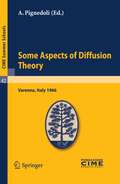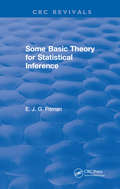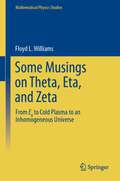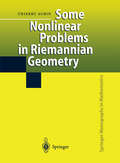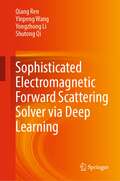- Table View
- List View
Solving the Mind-Body Problem by the CODAM Neural Model of Consciousness? (Springer Series in Cognitive and Neural Systems #9)
by John G. TaylorThis book details a model of consciousness supported by scientific experimental data from the human brain. It presents how the Corollary Discharge of Attention Movement (CODAM) neural network model allows for a scientific understanding of consciousness as well as provides a solution to the Mind-Body problem. The book provides readers with a general approach to consciousness that is powerful enough to lead to the inner self and its ramifications for the vast range of human experiences. It also offers an approach to the evolution of human consciousness and features chapters on mental disease (especially schizophrenia) and on meditative states (including drug-induced states of mind). Solving the Mind-Body Problem bridges the gap that exists between philosophers of mind and the neuroscience community, allowing the enormous weight of theorizing on the nature of mind to be brought to earth and put under the probing gaze of the scientific facts of life and mind.
Solving the Pell Equation (CMS Books in Mathematics)
by Michael Jacobson Hugh WilliamsPell’s Equation is a very simple Diophantine equation that has been known to mathematicians for over 2000 years. Even today research involving this equation continues to be very active, as can be seen by the publication of at least 150 articles related to this equation over the past decade. However, very few modern books have been published on Pell’s Equation, and this will be the first to give a historical development of the equation, as well as to develop the necessary tools for solving the equation. The authors provide a friendly introduction for advanced undergraduates to the delights of algebraic number theory via Pell’s Equation. The only prerequisites are a basic knowledge of elementary number theory and abstract algebra. There are also numerous references and notes for those who wish to follow up on various topics.
Some Aspects of Brownian Motion: Part II: Some Recent Martingale Problems (Lectures in Mathematics. ETH Zürich)
by Marc YorThe following notes represent approximately the second half of the lectures I gave in the Nachdiplomvorlesung, in ETH, Zurich, between October 1991 and February 1992, together with the contents of six additional lectures I gave in ETH, in November and December 1993. Part I, the elder brother of the present book [Part II], aimed at the computation, as explicitly as possible, of a number of interesting functionals of Brownian motion. It may be natural that Part II, the younger brother, looks more into the main technique with which Part I was "working", namely: martingales and stochastic calculus. As F. Knight writes, in a review article on Part I, in which research on Brownian motion is compared to gold mining: "In the days of P. Levy, and even as late as the theorems of "Ray and Knight" (1963), it was possible for the practiced eye to pick up valuable reward without the aid of much technology . . . Thereafter, however, the rewards are increasingly achieved by the application of high technology". Although one might argue whether this golden age is really foregone, and discuss the "height" of the technology involved, this quotation is closely related to the main motivations of Part II: this technology, which includes stochastic calculus for general discontinuous semi-martingales, enlargement of filtrations, . . .
Some Aspects of Diffusion Theory: Lectures given at a Summer School of the Centro Internazionale Matematico Estivo (C.I.M.E.) held in Varenna (Como), Italy, September 9-27,1966 (C.I.M.E. Summer Schools #42)
by A. PignedoliV.C.A. Ferraro: Diffusion of ions in a plasma with applications to the ionosphere.- P.C. Kendall: On the diffusion in the atmosphere and ionosphere.-F. Henin: Kinetic equations and Brownian motion.- T. Kahan:Théorie des réacteurs nucléaires: méthodes de résolution perturbationnelles, interactives et variationnelles.- C. Cattaneo: Sulla conduzione del calore.- C. Agostinelli: Formule di Green per la diffusione del campo magnetico in un fluido elettricamente conduttore.- A. Pignedoli: Transformational methods applied to some one-dimensional problems concerning the equations of the neutron transport theory.- A. Pignedoli: On the rigorous analysis of the problem of neutron transport in a slab geometry and on some other results.- G. Sestini: Principi di massimo per le soluzioni di equazioni paraboliche.
Some Aspects of Queueing and Storage Systems (Lecture Notes in Economics and Mathematical Systems #23)
by A. GhosalIn these lecture notes which grew out of my lectures at the Honours classes of Honash University, I have attempted to develop queueing and storage problems from a unified viewpoint. It has been recognized a decade ago that many of the queueing and storage problems belong to the same family of stochastic processes; so a problem in storage theory may bave an analogue in a queueing situation and vice versa. In my notes I have highlighted this aspect and tried to develop a broad perspective in a student rather than to work out in detail the various e~rcises in queueing and inventory problems which are mostly available in the literature produced so far. I have also pointed out some of the practical applications of some theoretical results which appear to be important for an Operational Research worker. Hany of the results given in these notes have cropped out of the author's own research over the last decade. Some new ideas which have scope for further exploitation have been given in most of the chapters (e. g. concept of cybernetic systems in Chapter 3, optimality problems in Chapter 4 and some problems in Chapter 2, etc. ): these may benefit graduate students. I thank my students for various discussions inside and outside the classrooms. I am also grateful to Mrs A. Darby for painfully and accurately typing out my manuscript. Ami tava Ghosal September 1969 Index Chapter 1.
Some Aspects of Ring Theory: Lectures given at a Summer School of the Centro Internazionale Matematico Estivo (C.I.M.E.) held in Varenna (Como), Italy, August 23-31, 1965 (C.I.M.E. Summer Schools #37)
by I. N. HersteinS. Amitsur: Associative rings with identities.- I.N. Herstein: Topics in ring theory.- N. Jacobson: Representation theory of Jordan algebras.- I. Kaplansky: The theory of homological dimension.- D. Buchsbaum: Complexes in local ring theory.- P.H. Cohn: Two topics in ring theory.- A.W. Goldie: Non-commutative localisation.
Some Basic Theory for Statistical Inference: Monographs on Applied Probability and Statistics
by E.J.G. PitmanIn this book the author presents with elegance and precision some of the basic mathematical theory required for statistical inference at a level which will make it readable by most students of statistics.
Some Basic Theory for Statistical Inference: Monographs on Applied Probability and Statistics
by E.J.G. PitmanIn this book the author presents with elegance and precision some of the basic mathematical theory required for statistical inference at a level which will make it readable by most students of statistics.
Some Fundamentals of Mathematics of Blockchain
by Julien RiposoThis book provides a foundation for the mathematics of blockchain. It is inspired by a general analysis and synthesis of the current knowledge of blockchain technology and starts by laying a foundation for the mathematics of blockchain. The aim is for research in the area of blockchain to lead their study from the construction highlighted in this book.First, the basis of a blockchain is set: block, transaction contents, block header, Merkle tree, nonce, Proof-of-Work. Connections with elliptic curves and cryptographic signatures are made.Second, the book ties this with a Graph and Matrix Theories approach and models the peer-to-peer relationship through the Bitcoin Network.Third, it is proposed further modelling, notably around halving, optimal storing, or diffusion of information, which are consequences of the mathematical foundation. The notion of Entropy of Privacy and the Particles model are introduced.Finally, the mathematical statements therein are proven and essential reminders can be found before each section, so the content can be accessible from a graduate level.
Some Improperly Posed Problems of Mathematical Physics (Springer Tracts in Natural Philosophy #11)
by Michail M. LavrentievThis monograph deals with the problems of mathematical physics which are improperly posed in the sense of Hadamard. The first part covers various approaches to the formulation of improperly posed problems. These approaches are illustrated by the example of the classical improperly posed Cauchy problem for the Laplace equation. The second part deals with a number of problems of analytic continuations of analytic and harmonic functions. The third part is concerned with the investigation of the so-called inverse problems for differential equations in which it is required to determine a dif ferential equation from a certain family of its solutions. Novosibirsk June, 1967 M. M. LAVRENTIEV Table of Contents Chapter I Formu1ation of some Improperly Posed Problems of Mathematic:al Physics § 1 Improperly Posed Problems in Metric Spaces. . . . . . . . . § 2 A Probability Approach to Improperly Posed Problems. . . 8 Chapter II Analytic Continuation § 1 Analytic Continuation of a Function of One Complex Variable from a Part of the Boundary of the Region of Regularity . . . . . . . . . . . . . . . . . . . . . . . . . . . . . 13 § 2 The Cauchy Problem for the Laplace Equation . . . . . . . 18 § 3 Determination of an Analytic Function from its Values on a Set Inside the Domain of Regularity. . . . . . . . . . . . . 22 § 4 Analytic Continuation of a Function of Two Real Variables 32 § 5 Analytic Continuation of Harmonic Functions from a Circle. . . . . . . . . . . . . . . . . . . . . . . . . . . . . . 38 § 6 Analytic Continuation of Harmonic Function with Cylin drical Symmetry . . . . . . . . . . . . . . . . . . . . . . . . . 42 Chapter III Inverse Problems for Differential Equations § 1 The Inverse Problem for a Newtonian Potential . . . . . . .
Some Mathematical Models from Population Genetics: École d'Été de Probabilités de Saint-Flour XXXIX-2009 (Lecture Notes in Mathematics #2012)
by Alison EtheridgeThis work reflects sixteen hours of lectures delivered by the author at the 2009 St Flour summer school in probability. It provides a rapid introduction to a range of mathematical models that have their origins in theoretical population genetics. The models fall into two classes: forwards in time models for the evolution of frequencies of different genetic types in a population; and backwards in time (coalescent) models that trace out the genealogical relationships between individuals in a sample from the population. Some, like the classical Wright-Fisher model, date right back to the origins of the subject. Others, like the multiple merger coalescents or the spatial Lambda-Fleming-Viot process are much more recent. All share a rich mathematical structure. Biological terms are explained, the models are carefully motivated and tools for their study are presented systematically.
Some Musings on Theta, Eta, and Zeta: From E8 to Cold Plasma to an lnhomogeneous Universe (Mathematical Physics Studies)
by Floyd L. WilliamsThis book continues the applications of mathematics, more specifically of theta, eta, and zeta functions, and modular forms, to various areas of theoretical physics. It is a follow-up and extension in some sense of the author’s earlier book entitled A window into zeta and modular physics. Some of the main topics are1. A new approach to logarithmic corrections to black hole entropy2. My recent work that provides for an explicit cold plasma-black hole connection3. Generalization of work of physicists on certain asymptotic problems relating to string theory, for example, by way of the general theory of modular forms of non-positive weight4. A construction of the E8 root lattice, its theta function, and its relevance for heterotic string theory5. Applications of elliptic functions to KdV, nonlinear Schrödinger, and Duffing equations, for example, including a discussion of Lax pairs and the Miura transformation6. Finite temperature zeta functions and partition functions for quantum fields in thermal equilibrium on various curved background spacetimes7. Exact solutions of the Einstein gravitational field equations for Lemaitre and inhomogeneous cosmological models, with a special focus on the Szekeres–Szafron exact solutions by way of the Weierstrass elliptic function8. Elementary particles and my zeta function formula for higher spin fermionic particles; this covers, in particular, the gravitino particle (of spin 3/2) and bosons with integral spin s = 2, 3, 4, 5.These are some sample topics. Others include the continuous Heisenberg model, reaction diffusion systems, Dirichlet and Hecke L-functions, the modular j-invariant, the computation of the one-loop effective potential for non-compact symmetric spaces, the BTZ black hole, Jacobi inversion formulas, etc.Thus, there is a very large range of material with the first 9 chapters of preliminary, expositional background for mathematicians and physicists.
Some Nonlinear Problems in Riemannian Geometry (Springer Monographs in Mathematics)
by Thierry AubinThis book deals with such important subjects as variational methods, the continuity method, parabolic equations on fiber bundles, ideas concerning points of concentration, blowing-up technique, geometric and topological methods. It explores important geometric problems that are of interest to many mathematicians and scientists but have only recently been partially solved.
Some Problems of Unlikely Intersections in Arithmetic and Geometry (AM-181)
by Umberto Zannier David MasserThis book considers the so-called Unlikely Intersections, a topic that embraces well-known issues, such as Lang's and Manin-Mumford's, concerning torsion points in subvarieties of tori or abelian varieties. More generally, the book considers algebraic subgroups that meet a given subvariety in a set of unlikely dimension. The book is an expansion of the Hermann Weyl Lectures delivered by Umberto Zannier at the Institute for Advanced Study in Princeton in May 2010. The book consists of four chapters and seven brief appendixes, the last six by David Masser. The first chapter considers multiplicative algebraic groups, presenting proofs of several developments, ranging from the origins to recent results, and discussing many applications and relations with other contexts. The second chapter considers an analogue in arithmetic and several applications of this. The third chapter introduces a new method for approaching some of these questions, and presents a detailed application of this (by Masser and the author) to a relative case of the Manin-Mumford issue. The fourth chapter focuses on the André-Oort conjecture (outlining work by Pila).
Some Problems of Unlikely Intersections in Arithmetic and Geometry (AM-181)
by Umberto Zannier David MasserThis book considers the so-called Unlikely Intersections, a topic that embraces well-known issues, such as Lang's and Manin-Mumford's, concerning torsion points in subvarieties of tori or abelian varieties. More generally, the book considers algebraic subgroups that meet a given subvariety in a set of unlikely dimension. The book is an expansion of the Hermann Weyl Lectures delivered by Umberto Zannier at the Institute for Advanced Study in Princeton in May 2010. The book consists of four chapters and seven brief appendixes, the last six by David Masser. The first chapter considers multiplicative algebraic groups, presenting proofs of several developments, ranging from the origins to recent results, and discussing many applications and relations with other contexts. The second chapter considers an analogue in arithmetic and several applications of this. The third chapter introduces a new method for approaching some of these questions, and presents a detailed application of this (by Masser and the author) to a relative case of the Manin-Mumford issue. The fourth chapter focuses on the André-Oort conjecture (outlining work by Pila).
Some Properties of Differentiable Varieties and Transformations: With Special Reference to the Analytic and Algebraic Cases (Ergebnisse der Mathematik und ihrer Grenzgebiete. 2. Folge #13)
by Beniamino SegreThe present volume contains, together with numerous additions and extensions, the course of lectures which I gave at Pavia (26 September till 5 October 1955) by invitation of the «Centro Internazionale Mate matico Estivo». The treatment has the character of a monograph, and presents various novel features, both in form and in substance; these are indicated in the notes which will be found at the beginning and end of each chapter. Of the nine parts into which the work is divided, the first four are essentially differential in character, the next three deal with algebraic geometry, while the last two are concerned with certain aspects of the theory of differential equations and of correspondences between topo logical varieties. A glance at the index will suffice to give a more exact idea of the range and variety of the contents, whose chief characteristic is that of establishing suggestive and sometimes unforeseen relations between apparently diverse subjects (e. g. differential geometry in the small and also in the large, algebraic geometry, function theory, topo logy, etc.); prominence is given throughout to the geometrical viewpoint, and tedious calculations are as far as possible avoided.
Some Properties of Differentiable Varieties and Transformations: With Special Reference to the Analytic and Algebraic Cases (Ergebnisse der Mathematik und ihrer Grenzgebiete. 2. Folge #13)
by Beniamino SegreThe present volume contains, together with numerous addition and extensions, the course of lectures which I gave at Pavia (26 September till 5 October 1955) by invitation of the «Centro Internazionale Mate matico Estivo». The treatment has the character of a monograph, and presents various novel features, both in form and in substance; these are indicated in the notes which will be found at the beginning and end of each chapter, Of the nine parts into which the work is divided, the first four are essentially differential in character, the next three deal with algebraic geometry, while the last two are concerned with certain aspects of the theory of differential equations and of correspondences between topo logical varieties. A glance at the index will suffice to give a more exact idea of the range and variety of the contents, whose chief characteristic is that of establishing suggestive and sometimes unforeseen relations between apparently diverse subjects (e. g. differential geometry in the small and also in the large, algebraic geometry, function theory, topo logy, etc. ); prominence is given throughout to the geometrical view point, and tedious calculations are as far as possible avoided. The exposition has been planned so that it can be followed without much difficulty even by readers who have no special knowledge of the subjects treated.
Some Tapas of Computer Algebra (Algorithms and Computation in Mathematics #4)
by Arjeh M. Cohen Hans Cuypers Hans SterkThis book presents the basic concepts and algorithms of computer algebra using practical examples that illustrate their actual use in symbolic computation. A wide range of topics are presented, including: Groebner bases, real algebraic geometry, lie algebras, factorization of polynomials, integer programming, permutation groups, differential equations, coding theory, automatic theorem proving, and polyhedral geometry. This book is a must read for anyone working in the area of computer algebra, symbolic computation, and computer science.
Some Topics in Algebra: An Advanced Undergraduate Course at PKU (Mathematical Lectures from Peking University)
by Michel BrouéDuring the springs of 2011 and 2012, the author was invited by Peking University to give an advanced undergraduate algebra course (once a week over two months each year). This book was written during and for that course. By no way does it claim to be too exhaustive. It was originally intended as a brief introduction to algebra for an extremely pleasant and passionate audience. It certainly reflects some of the author’s own tastes, and it was influenced by the feelings and the reactions of the students.Nevertheless, the result covers some advanced undergraduate algebra (rings, ideals, basics of fields theory, algebraic integers, modules, hom and tensor functors, projective modules, etc.) illustrated by numerous examples, counterexamples and exercises. Following a worldwide tradition, the author had planned to conclude by lecturing on the structure of finitely generated modules over principal ideal domains. But during the course, after explaining that the notion of projective modules is more natural than the notion of free modules, it became clear that principal ideal domains needed to be replaced by Dedekind rings; this is much less traditional in the literature — but not more difficult.
Some Unusual Topics in Quantum Mechanics (SpringerBriefs in Physics)
by Pankaj SharanIn this book, the author addresses selected topics in quantum mechanics that are not usually covered in books, but which are very helpful in developing a student's interest in, and a deeper understanding of the subject. The topics include two different ways of looking at quantum mechanics; three clarifying topics that students often find confusing; one classic theorem never proved in the classroom; and a discussion on whether there can be a non-linear quantum mechanics. The book can be used as supporting material for graduate-level core courses on quantum mechanics.
Some Unusual Topics in Quantum Mechanics (Lecture Notes in Physics #1020)
by Pankaj SharanThis second edition of Some Unusual Topics in Quantum Mechanics builds upon the topics covered in the first, with additional chapters that delve deeper into the mathematical foundations of the subject. New topics include Hilbert spaces and unbounded operators, minimum uncertainty states, path integrals in general coordinates, Fock spaces, second quantization, relativistic particle states, and quantum fields. Historical insights are also included, such as a pre-history of matrix mechanics and Pauli's proof of the H-atom spectrum using O(4) symmetry. Finally, readers are introduced to Bell's inequality and the non-locality in quantum mechanics that is revealed through its violation. These topics are rarely covered in introductory textbooks but are crucial to developing a student's interest and deeper understanding of quantum mechanics. This book serves as valuable supporting material for graduate-level core courses on the subject.
Sophie Germain: Revolutionary Mathematician (Springer Biographies)
by Dora MusielakThis biography of the mathematician, Sophie Germain, paints a rich portrait of a brilliant and complex woman, the mathematics she developed, her associations with Gauss, Legendre, and other leading researchers, and the tumultuous times in which she lived. Sophie Germain stood right between Gauss and Legendre, and both publicly recognized her scientific efforts. Unlike her female predecessors and contemporaries, Sophie Germain was an impressive mathematician and made lasting contributions to both number theory and the theories of plate vibrations and elasticity. She was able to walk with ease across the bridge between the fields of pure mathematics and engineering physics. Though isolated and snubbed by her peers, Sophie Germain was the first woman to win the prize of mathematics from the French Academy of Sciences. She is the only woman who contributed to the proof of Fermat’s Last Theorem. In this unique biography, Dora Musielak has done the impossible―she has chronicled Sophie Germain’s brilliance through her life and work in mathematics, in a way that is simultaneously informative, comprehensive, and accurate.
Sophisticated Electromagnetic Forward Scattering Solver via Deep Learning
by Qiang Ren Yinpeng Wang Yongzhong Li Shutong QiThis book investigates in detail the deep learning (DL) techniques in electromagnetic (EM) near-field scattering problems, assessing its potential to replace traditional numerical solvers in real-time forecast scenarios. Studies on EM scattering problems have attracted researchers in various fields, such as antenna design, geophysical exploration and remote sensing. Pursuing a holistic perspective, the book introduces the whole workflow in utilizing the DL framework to solve the scattering problems. To achieve precise approximation, medium-scale data sets are sufficient in training the proposed model. As a result, the fully trained framework can realize three orders of magnitude faster than the conventional FDFD solver. It is worth noting that the 2D and 3D scatterers in the scheme can be either lossless medium or metal, allowing the model to be more applicable. This book is intended for graduate students who are interested in deep learning with computational electromagnetics, professional practitioners working on EM scattering, or other corresponding researchers.
Sorting: A Distribution Theory (Wiley Series in Discrete Mathematics and Optimization #54)
by Hosam M. MahmoudA cutting-edge look at the emerging distributional theory of sorting Research on distributions associated with sorting algorithms has grown dramatically over the last few decades, spawning many exact and limiting distributions of complexity measures for many sorting algorithms. Yet much of this information has been scattered in disparate and highly specialized sources throughout the literature. In Sorting: A Distribution Theory, leading authority Hosam Mahmoud compiles, consolidates, and clarifies the large volume of available research, providing a much-needed, comprehensive treatment of the entire emerging distributional theory of sorting. Mahmoud carefully constructs a logical framework for the analysis of all standard sorting algorithms, focusing on the development of the probability distributions associated with the algorithms, as well as other issues in probability theory such as measures of concentration and rates of convergence. With an emphasis on narrative rather than technical explanations, this exceptionally well-written book makes new results easily accessible to a broad spectrum of readers, including computer professionals, scientists, mathematicians, and engineers. Sorting: A Distribution Theory: * Contains introductory material on complete and partial sorting * Explains insertion sort, quick sort, and merge sort, among other methods * Offers verbal descriptions of the mechanics of the algorithms as well as the necessary code * Illustrates the distribution theory of sorting using a broad array of both classical and modern techniques * Features a variety of end-of-chapter exercises
Soul Made Flesh: How The Secrets of the Brain were uncovered in Seventeenth Century England
by Carl ZimmerAt the beginning of Europe's turbulent seventeenth century, no one knew how the brain worked. By the century's close, the science of the brain had taken root, helping to overturn many common misconceptions about the human body as well as to unseat centuries-old philosophies of man and God. Presiding over this evolution was the founder of modern neurology, Thomas Willis, a fascinating, sympathetic, even heroic figure who stands at the centre of an extraordinary group of scientists and philosophers known as the 'Oxford circle'. Chronicled here in vivid detail are their groundbreaking revelations and often gory experiments that first enshrined the brain as the chemical engine of reason, emotion, and madness - indeed as the very seat of the human soul.



